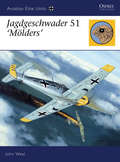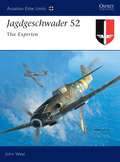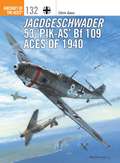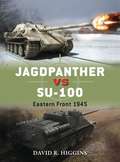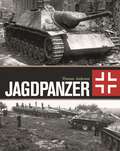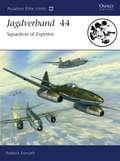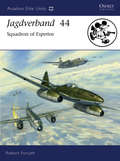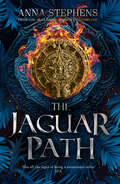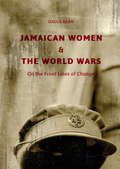- Table View
- List View
Jagdgeschwader 51 ‘Mölders’ (Aviation Elite Units #22)
by John WealJG 51 were one of the Luftwaffe's top wartime fighter units, yet their story has never been told in English. The unit's history encapsulates the fortunes of the Luftwaffe's fighter arm as a whole the heady successes of the early months, the steady attrition and the growing strength of the opposition during the mid-war years, and the final chaos and collapse of the last days. But it is perhaps the details of the pilots who served with the unit that sets JG 51 apart. During the course of the war it numbered more Knight's Cross winners among its ranks than any other. And it is their stories – their successes, exploits and eventual fates – which brings this history to life.
Jagdgeschwader 52: The Experten (Aviation Elite Units)
by John WealJagdgeschwader 52 (JG 52) was the most successful and highest-scoring fighter unit, not just in Germany's World War 2 Luftwaffe, but in the entire annals of aviation history. No other fighter group has ever come close to matching its staggering total of around 9000 enemy aircraft shot down in combat. And yet, because much of that combat took place over the tractless wastes of the Russian front, very little has been written in English about the exploits of this charismatic unit. This book provides a full combat history of JG 52 and its members, including the three top-scoring aces of all time, who claimed a total of 900 victories between them.
Jagdgeschwader 52: The Experten (Aviation Elite Units #15)
by John WealJagdgeschwader 52 (JG 52) was the most successful and highest-scoring fighter unit, not just in Germany's World War 2 Luftwaffe, but in the entire annals of aviation history. No other fighter group has ever come close to matching its staggering total of around 9000 enemy aircraft shot down in combat. And yet, because much of that combat took place over the tractless wastes of the Russian front, very little has been written in English about the exploits of this charismatic unit. This book provides a full combat history of JG 52 and its members, including the three top-scoring aces of all time, who claimed a total of 900 victories between them.
Jagdgeschwader 53 'Pik-As' (Aviation Elite Units)
by John Weal Mark PostlethwaiteArguably the archetypal Luftwaffe fighter unit of World War 2, JG 53 aircraft were encountered on almost every fighting front from the first day of hostilities until the last. During almost six years of near-constant campaigning, JG 53 took a steady toll of Allied aircraft in every theatre it fought over. The variety of camouflage finishes worn by its machines -winter white, desert dapple and Reich's defence black and the progression of variants are reflected in an eye-opening colour section. John Weal has spent several years researching in German archives and this, together with his personal contact with several veterans, results in an authoritative and human account of JG 53's long and eventful war.
Jagdgeschwader 53 'Pik-As' (Aviation Elite Units)
by John Weal Mark PostlethwaiteArguably the archetypal Luftwaffe fighter unit of World War 2, JG 53 aircraft were encountered on almost every fighting front from the first day of hostilities until the last. During almost six years of near-constant campaigning, JG 53 took a steady toll of Allied aircraft in every theatre it fought over. The variety of camouflage finishes worn by its machines -winter white, desert dapple and Reich's defence black and the progression of variants are reflected in an eye-opening colour section. John Weal has spent several years researching in German archives and this, together with his personal contact with several veterans, results in an authoritative and human account of JG 53's long and eventful war.
Jagdgeschwader 53 ‘Pik-As’ Bf 109 Aces of 1940 (Aircraft of the Aces #132)
by Chris Davey Chris GossBoasting pilots who had been blooded in the Spanish Civil War, Jagdgeschwader 53 (JG 53) 'Pik As' or 'Ace of Spades' achieved great success in the skies over France and Britain in 1940. It was infamous amongst its opponents for the quality and calibre of its aces – men such as Werner Mölders, Hans-Karl Mayer and Rolf Pingel. These aces won numerous Knight's Crosses for their exploits in 1940, credited with 258 victories, with 51 pilots being killed or captured. This study follows these pilots of JG 53 into battle, telling the stories of their victories, losses, and ultimate fate.Containing 36 profile illustrations depicting the drastic change in appearance of their aircraft over time, and complemented by thorough research, this book is a welcome addition to Osprey's popular Aircraft of the Aces series.
Jagdgeschwader 53 ‘Pik-As’ Bf 109 Aces of 1940 (Aircraft of the Aces #132)
by Chris Davey Chris GossBoasting pilots who had been blooded in the Spanish Civil War, Jagdgeschwader 53 (JG 53) 'Pik As' or 'Ace of Spades' achieved great success in the skies over France and Britain in 1940. It was infamous amongst its opponents for the quality and calibre of its aces – men such as Werner Mölders, Hans-Karl Mayer and Rolf Pingel. These aces won numerous Knight's Crosses for their exploits in 1940, credited with 258 victories, with 51 pilots being killed or captured. This study follows these pilots of JG 53 into battle, telling the stories of their victories, losses, and ultimate fate.Containing 36 profile illustrations depicting the drastic change in appearance of their aircraft over time, and complemented by thorough research, this book is a welcome addition to Osprey's popular Aircraft of the Aces series.
Jagdgeschwader 54 'Grünherz' (Aviation Elite Units)
by John WealOne of the most successful of the high-scoring Luftwaffe Jagdgeschwader during World War 2, JG 54 'Grünherz' (Green Hearts) was formed from three disparate fighter 'Gruppen' immediately prior to the Battle of Britain. Having enjoyed immediate success over the Channel and South-east England during the summer of 1940, the unit was transferred to the Eastern Front in the spring of 1941 in preparation for Operation Barbarossa the German invasion of the Soviet Union. JG 54 would remain a Jagdwaffe stalwart in the east, flying firstly Bf 109Fs and then the Fw 190. By war's end, the Geschwader's pilots had claimed over 9500 kills, and produced over 100 aces. Men like Hans Philipp, Walter Nowotny and Otto Kittel are profiled in this volume, which reveals the struggle in the face of overwhelming odds that was the lot of the Jagdflieger on the Eastern Front.
Jagdgeschwader 54 'Grünherz' (Aviation Elite Units #6)
by John WealOne of the most successful of the high-scoring Luftwaffe Jagdgeschwader during World War 2, JG 54 'Grünherz' (Green Hearts) was formed from three disparate fighter 'Gruppen' immediately prior to the Battle of Britain. Having enjoyed immediate success over the Channel and South-east England during the summer of 1940, the unit was transferred to the Eastern Front in the spring of 1941 in preparation for Operation Barbarossa the German invasion of the Soviet Union. JG 54 would remain a Jagdwaffe stalwart in the east, flying firstly Bf 109Fs and then the Fw 190. By war's end, the Geschwader's pilots had claimed over 9500 kills, and produced over 100 aces. Men like Hans Philipp, Walter Nowotny and Otto Kittel are profiled in this volume, which reveals the struggle in the face of overwhelming odds that was the lot of the Jagdflieger on the Eastern Front.
Jagdgeschwader 7 ‘Nowotny’ (Aviation Elite Units #29)
by Jim Laurier Robert ForsythALSO AVAILABLE AS AN E-BOOK. When the revolutionary Messerschmitt Me 262 jet fighter first appeared in the skies over northwest Europe in mid-1944, it represented one of the greatest challenges to Allied air superiority. The first group to solely fly jet fighters, Jagdgeschwader 7 was tasked with wrestling back command of the skies. Put almost immediately into action, despite fuel shortages, poor training and problems with the jet engine, victories quickly followed against both US and British aircraft. By the end of the war, the Jagdgeschwader had claimed nearly 200 enemy aircraft destroyed in daylight bomber raids during 1945. This book follows the history of the JG 7 unit, examining how their courage, determination and the most advanced aircraft in the world were simply not enough to ensure victory. In the final section of the book Robert Forsyth details how JG 7 were eventually defeated by gradual losses, restricted operating conditions, lack of fuel and overwhelming Allied fighter strength.
Jagdpanther vs SU-100: Eastern Front 1945 (Duel)
by Richard Chasemore David R. HigginsAs World War II in Europe reached its end, armour development and doctrine had experienced several years of massively accelerated change, especially within the crucible of the Eastern Front. The German Jagdpanther and Soviet SU-100, both turretless tank-destroyer designs based on a 'traditional' turret-tank chassis, were the culminating examples of how the progression of experience, resources and time constraints produced vehicles that were well suited for roles of defence and offence, respectively. The Jagdpanther represented a well-balanced solution and an excellent use of limited resources, while the SU-100 was a natural progression of the SU-85, where numbers produced compensated for rudimentary construction, poor crew comfort and limited optics.
Jagdpanther vs SU-100: Eastern Front 1945 (Duel #58)
by Richard Chasemore David R. HigginsAs World War II in Europe reached its end, armour development and doctrine had experienced several years of massively accelerated change, especially within the crucible of the Eastern Front. The German Jagdpanther and Soviet SU-100, both turretless tank-destroyer designs based on a 'traditional' turret-tank chassis, were the culminating examples of how the progression of experience, resources and time constraints produced vehicles that were well suited for roles of defence and offence, respectively. The Jagdpanther represented a well-balanced solution and an excellent use of limited resources, while the SU-100 was a natural progression of the SU-85, where numbers produced compensated for rudimentary construction, poor crew comfort and limited optics.
Jagdpanzer
by Thomas AndersonThis highly illustrated title details the history of the Jagdpanzer, the self-propelled German tank destroyers introduced in the second half of World War II. Throughout World War II all sides grappled with how to deal with the threat of enemy armour. The German Army had adopted the 3.7cm anti-tank gun in the inter-war years. However, it was already apparent that the towed weapons lacked firepower and more powerful weapons were introduced in 1942 and 1943.By 1942, hard-pressed Panzerjäger (anti-tank) units equipped with towed anti-tank weapons fighting on the Eastern Front increasingly sought assistance from StuG-equipped assault artillery units. By late 1943 the StuG was being issued to new tank destroyer units and at the same time a dedicated Jagdpanzer (hunting tank) was ordered, based on the chassis and running gear of the PzKpfw IV.This highly illustrated study by German armour expert Thomas Anderson uses archival material and after-action reports to describe the development of the Jagdpanzer, and the many variants built on other German tank chassis. It also covers in detail how Jagdpanzer units were organized as well as their operational experience on the battlefield.
Jagdpanzer
by Thomas AndersonThis highly illustrated title details the history of the Jagdpanzer, the self-propelled German tank destroyers introduced in the second half of World War II. Throughout World War II all sides grappled with how to deal with the threat of enemy armour. The German Army had adopted the 3.7cm anti-tank gun in the inter-war years. However, it was already apparent that the towed weapons lacked firepower and more powerful weapons were introduced in 1942 and 1943.By 1942, hard-pressed Panzerjäger (anti-tank) units equipped with towed anti-tank weapons fighting on the Eastern Front increasingly sought assistance from StuG-equipped assault artillery units. By late 1943 the StuG was being issued to new tank destroyer units and at the same time a dedicated Jagdpanzer (hunting tank) was ordered, based on the chassis and running gear of the PzKpfw IV.This highly illustrated study by German armour expert Thomas Anderson uses archival material and after-action reports to describe the development of the Jagdpanzer, and the many variants built on other German tank chassis. It also covers in detail how Jagdpanzer units were organized as well as their operational experience on the battlefield.
Jagdverband 44: Squadron of Experten (Aviation Elite Units)
by Jim Laurier Robert ForsythThere was no Luftwaffe fighter unit like Jagdverband 44. Formed in February 1945, the unit grew out of Hitler's bizarre decision that the Me 262 jet fighter should be used as a bomber, despite its potential in the daylight defensive battles over the Reich. Seen as a grave mistake by Göring, a small fighter unit was formed in southern Germany to 'prove' the Me 262's ability as an interceptor. Formed with some of Germany's most experienced fighter pilots, Jagdverband 44 numbered a disproportionately high number of leading aces in its ranks, to the extent that it was said that the Knights' Cross was the unofficial badge of the unit. With numerous first-hand accounts from pilots and detailed colour profiles, this book is a fascinating account of the dramatic birth of the jet fighter and the impact it had during the bitter struggles of 1944-45.
Jagdverband 44: Squadron of Experten (Aviation Elite Units)
by Jim Laurier Robert ForsythThere was no Luftwaffe fighter unit like Jagdverband 44. Formed in February 1945, the unit grew out of Hitler's bizarre decision that the Me 262 jet fighter should be used as a bomber, despite its potential in the daylight defensive battles over the Reich. Seen as a grave mistake by Göring, a small fighter unit was formed in southern Germany to 'prove' the Me 262's ability as an interceptor. Formed with some of Germany's most experienced fighter pilots, Jagdverband 44 numbered a disproportionately high number of leading aces in its ranks, to the extent that it was said that the Knights' Cross was the unofficial badge of the unit. With numerous first-hand accounts from pilots and detailed colour profiles, this book is a fascinating account of the dramatic birth of the jet fighter and the impact it had during the bitter struggles of 1944-45.
The Jaguar Path (The Songs of the Drowned #2)
by Anna StephensBook Two of the new epic fantasy trilogy by the acclaimed author of GODBLIND.
The Jail Busters: The Secret Story of MI6, the French Resistance and Operation Jericho
by Robert LymanIn the new year of 1944 the French Resistance in northern France was on its knees. Relentless attacks on its diverse and disorganised networks by the Gestapo and the Abwehr had put many of its best operatives in prison, or worse. But in the lead up to Operation Overlord, 'D Day', the Resistance had never been more important to the Allied war effort, and many groups were in the pay of Britain's Secret Intelligence Service, MI6. One such was organised by a patriot called Dominic Ponchardier. For months he had watched helplessly as his friends and colleagues had been swept up by the Nazi drag net, and cast into the old prison on the eastern outskirts of Amiens. In desperation he asked his MI6 handlers for help, and once London agreed it led to one of the most daring missions of the war. On the morning of 18 February 1944, nineteen Mosquito bombers flew at low level across the channel, skimming just above the ground to drop their bombs on sections of the walls of Amiens Prison. Hundreds escaped, scores of whom evaded recapture to continue the fight against Nazi repression. It was an epic of precision bombing, in which one of the most notable RAF heroes of the war, Group Captain Charles Pickard, lost his life. Robert Lyman's book reveals, from previously unseen sources, the full truth of MI6's involvement in the French Resistance, and narrates in vivid detail a stirring tale of courage and skill.
Jam and Roses (The Factory Girls)
by Mary GibsonThe poignant and powerful second novel from the bestselling author of Custard Tarts and Broken Hearts. London, 1923. Bermondsey is the larder of London with its bustling docks, spice mill, tannery and factories. Milly Colman knows she's lucky. Working at Southwell's jam factory all week means she can have a pay packet and a laugh with her mates come Saturday. It's a welcome escape from home, where Milly must protect her mother and sisters from her father's violent temper. When autumn comes, hop-picking in Kent gives all the Colman women a longed-for respite. But it is there, on one golden September night, that Milly makes the mistake of her life and finds her courage and strength tested as never before. PRAISE FOR JAM AND ROSES: 'This book is raw and powerful and a fabulous read. This is where girl power came from; women like Milly and her family, girls who did not even have the vote at this time. This book is also a history lesson, telling the story of the general strike' Mrs H, Amazon reviewer. 'Well written, with pace, engaging characters, a good narrative and some suspense. A real authentic tone, too: the central characters reminded me of the formidable spirit of my mother/grandmothers who lived through, and survived, these demanding times' Fredmart, Amazon reviewer. 'A fantastic read! I was hooked from the first paragraph, Mary Gibson is a fabulous and talented writer. A book you can't put down but, yet you want to find out the ending without wanting the book to finish. Well done and thank you. Can't wait to read the next book' Michelle Thompson, Amazon reviewer. 'If you enjoy post war stories of women's hardship, based in london, then this is the book to read. It kept me enthralled from the start. Highly recommended' Shell R, Amazon reviewer. 'So full of emotion and tragedies, but also humour, happiness, love and hate' Patsy, Amazon reviewer.
The Jam Factory Girls (The Jam Factory Girls)
by Mary WoodThe Jam Factory Girls is an uplifting and emotional novel of friendship set in the heart of pre-WWI London from bestselling author, Mary Wood.Life for Elsie is difficult as she struggles to cope with her alcoholic mother. Caring for her siblings and working long hours at Swift's Jam factory in London’s Bermondsey is exhausting. Thankfully her lifelong friendship with Dot helps to smooth over life’s rough edges. When Elsie and Dot meet Millie Swift, they are nervous to be in the presence of the bosses’ daughter. Over time, they are surprised to feel so drawn to her, but should two East End girls be socializing in such circles? When disaster strikes, it binds the women in ways they could never imagine. Long-held secrets are revealed that could change all their lives . . .
The Jam Factory Girls Fight Back (The Jam Factory Girls #3)
by Mary WoodThe Jam Factory Girls Fight Back is a moving novel of friendship set in the heart of pre-WWI London from bestselling author, Mary Wood.Can they claim what is rightfully theirs?From the moment Len came into their lives, everything changed for Millie and Elsie. Both fell in love with him, but he chose Millie, because of her attractive legacy – the Jam Factory.Millie’s expecting Len’s baby and it should be the happiest time, but her husband’s true colours have come to the fore – and Millie is forced to leave the marriage. Now Millie is desperate to save her child from Len’s clutches. Will Len ever allow her to find happiness?Elsie’s fallen in love with dependable Jim – but Len is threatening their happiness too. Elsie and Millie are determined to overthrow Len and reclaim the Jam Factory as their own. Will they succeed, and can they rebuild their lives after the devastation Len has caused?
Jamaican Women and the World Wars: On the Front Lines of Change
by Dalea BeanThis book highlights the important, yet often forgotten, roles that Jamaican women played in the World Wars. Predicated on the notion that warfare has historically been an agent of change, Dalea Bean contends that traces of this truism were in Jamaica and illustrates that women have historically been part of the war project, both as soldiers and civilians. This ground-breaking work fills a gap in the historiography of Jamaican women by positioning the World Wars as watershed periods for their changing roles and status in the colony. By unearthing critical themes such as women’s war work as civilians, recruitment of men for service in the British West India Regiment, the local suffrage movement in post-Great War Jamaica, and Jamaican women’s involvement as soldiers in the British Army during the Second World War, this book presents the most extensive and holistic account of Jamaican women’s involvement in the wars.
Jamaican Women and the World Wars: On the Front Lines of Change
by Dalea BeanThis book highlights the important, yet often forgotten, roles that Jamaican women played in the World Wars. Predicated on the notion that warfare has historically been an agent of change, Dalea Bean contends that traces of this truism were in Jamaica and illustrates that women have historically been part of the war project, both as soldiers and civilians. This ground-breaking work fills a gap in the historiography of Jamaican women by positioning the World Wars as watershed periods for their changing roles and status in the colony. By unearthing critical themes such as women’s war work as civilians, recruitment of men for service in the British West India Regiment, the local suffrage movement in post-Great War Jamaica, and Jamaican women’s involvement as soldiers in the British Army during the Second World War, this book presents the most extensive and holistic account of Jamaican women’s involvement in the wars.
James Connolly: 16Lives (16lives Ser. #1)
by Lorcan CollinsJames Connolly (1868-1916) became a leading Irish socialist and revolutionary, and was one of the leaders of Ireland's rebellion in 1916. As a youth he had served in the British army in Ireland and, seeing how they treated the local population, became hugely disillusioned with the British Army. He became involved in socialism in Scotland and was the driving force behind the creation of Ireland’s trade union movement. He was Commandant of the Dublin Brigade in the Easter Rising and, too injured to stand before the firing squad, was executed tied to a chair. Written in an entertaining, educational and assessible style, this biography is an accurate and well-researched portrayal of the man behind the uprising. Including the latest archival evidence, James Connolly is part of the Sixteen Lives series which looks at the events, lives and deeds of the sixteen men executed for their role in Ireland’s Easter 1916 Rising.
James the Third
by Maggie BallingerIn 1936, the Duke of York unexpectedly became King George VI, and his ten-year-old daughter, Princess Elizabeth, became heir presumptive. However, she was never heir apparent, because a male sibling would automatically assume her place in the line of succession. So what would have happened upon the late arrival of a baby brother for the grown-up Princesses Elizabeth and Margaret? After King George VI’s death in 1952, the United Kingdom’s next sovereign would have been a very young boy, and one in need of a regent. James the Third tells that boy’s story. How does his reign unfold? He is clever, resourceful and unconventional − but can he alter the course of history, given the limited role of a constitutional monarch? Does he find true love, or must he accept second best? And, with the births of his heirs, what does the House of Windsor look like now? Set against rapidly changing times, there is a parallel tale of two working class sisters from the East End of London. As fans of the royal family, they are closer to the crown than they could ever imagine. Seamlessly blending the twists and turns of fiction with historical fact, this book is sure to please anyone who enjoys a glimpse of life behind palace walls.
